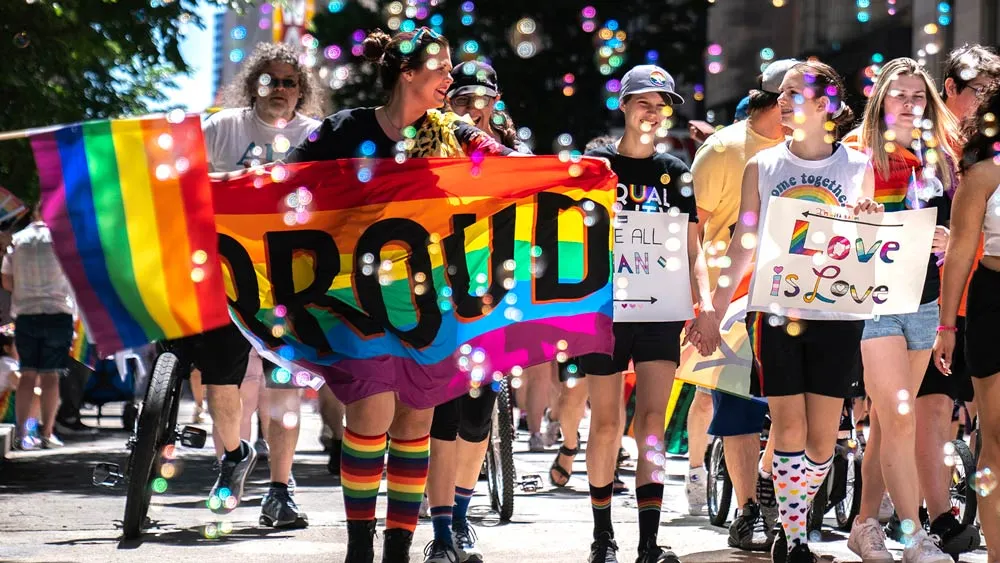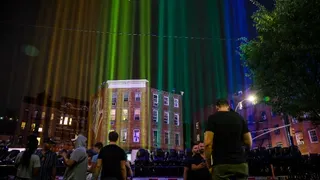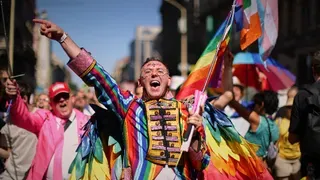January 19, 2021
'Shameful': US Virus Deaths Top 400K as Trump Leaves Office
Adam Geller, Janie Har READ TIME: 5 MIN.
As President Donald Trump entered the final year of his term last January, the U.S. recorded its first confirmed case of COVID-19. Not to worry, Trump insisted, his administration had the virus "totally under control."
Now, in his final hours in office, after a year of presidential denials of reality and responsibility, the pandemic's U.S. death toll has eclipsed 400,000. And the loss of lives is accelerating.
"This is just one step on an ominous path of fatalities," said Dr. Irwin Redlener, director of the National Center for Disaster Preparedness at Columbia University and one of many public health experts who contend the Trump administration's handling of the crisis led to thousands of avoidable deaths.
"Everything about how it's been managed has been infused with incompetence and dishonesty, and we're paying a heavy price," he said.
The 400,000-death toll, reported Tuesday by Johns Hopkins University, is greater than the population of New Orleans, Cleveland or Tampa, Florida. It's nearly equal to the number of American lives lost annually to strokes, Alzheimer's disease, diabetes, flu and pneumonia combined.
With more than 4,000 deaths recorded on some recent days – the most since the pandemic began – the toll by week's end will probably surpass the number of Americans killed in World War II.
"We need to follow the science and the 400,000th death is shameful," said Cliff Daniels, chief strategy officer for Methodist Hospital of Southern California, near Los Angeles. With its morgue full, the hospital has parked a refrigerated truck outside to hold the bodies of COVID-19 victims until funeral homes can retrieve them.
"It's so incredibly, unimaginably sad that so many people have died that could have been avoided," he said.
President-elect Joe Biden, who will be sworn in on Wednesday, planned to take part in an evening ceremony Tuesday near the Lincoln Memorial in Washington to honor the 400,000 dead. The bell at the Washington National Cathedral was set to toll 400 times. Other cities around the U.S. planned tributes as well.
The U.S. accounts for nearly 1 of every 5 virus deaths reported worldwide, far more than any other country despite its great wealth and medical resources.
The coronavirus would almost certainly have posed a grave crisis for any president given its rapid spread and power to kill, experts on public health and government said.
But Trump seemed to invest as much in battling public perceptions as he did in fighting the virus itself, repeatedly downplaying the threat and rejecting scientific expertise while fanning conflicts ignited by the outbreak.
As president he was singularly positioned to counsel Americans. Instead, he used his pulpit to spout theories – refuted by doctors – that taking unproven medicines or even injecting household disinfectant might save people from the virus.
The White House defended the administration this week.
"We grieve every single life lost to this pandemic, and thanks to the president's leadership, Operation Warp Speed has led to the development of multiple safe and effective vaccines in record time, something many said would never happen," said White House spokesman Judd Deere.
With deaths spiraling in the New York City area last spring, Trump declared "war" on the virus. But he was slow to invoke the Defense Production Act to secure desperately needed medical equipment. Then he sought to avoid responsibility for shortfalls, saying that the federal government was "merely a backup" for governors and legislatures.
"I think it is the first time in history that a president has declared a war and we have experienced a true national crisis and then dumped responsibility for it on the states," said Drew Altman, president of the Kaiser Family Foundation, a health care policy think tank.
When the Centers for Disease Control and Prevention tried to issue guidelines for reopening in May, Trump administration officials held them up and watered them down. As the months passed, Trump claimed he was smarter than the scientists and belittled experts like Dr. Anthony Fauci, the government's top authority on infectious diseases.
"Why would you bench the CDC, the greatest fighting force of infectious disease in the world? Why would you call Tony Fauci a disaster?" asked Dr. Howard Markel, a medical historian at the University of Michigan. "It just doesn't make sense."
As governors came under pressure to reopen state economies, Trump pushed them to move faster, asserting falsely that the virus was fading. "LIBERATE MINNESOTA!" he tweeted in April as angry protesters gathered at the state Capitol to oppose the Democratic governor's stay-at-home restrictions. "LIBERATE MICHIGAN!"
In Republican-led states like Arizona that allowed businesses to reopen, hospitals and morgues filled with virus victims.
"It led to the tragically sharp partisan divide we've seen in the country on COVID, and that has fundamental implications for where we are now, because it means the Biden administration can't start over," Altman said. "They can't put the genie back in the bottle."
In early October, when Trump himself contracted COVID-19, he ignored safety protocols, ordering up a motorcade so he could wave to supporters outside his hospital. Once released, he appeared on the White House balcony to take off his mask for the cameras, making light of health officials' pleas for people to cover their faces.
"We're rounding the corner," Trump said of the battle with the virus during a debate with Biden in late October. "It's going away."
It isn't. U.S. deaths from COVID-19 surpassed 100,000 in late May, then tripled by mid-December. Experts at the University of Washington project deaths will reach nearly 567,000 by May 1.
More than 120,000 patients with the virus are in the hospital in the U.S., according to the COVID Tracking Project, twice the number who filled wards during previous peaks. On a single day last week, the U.S. recorded more than 4,400 deaths.
While vaccine research funded by the administration as part of Warp Speed has proved successful, the campaign trumpeted by the White House to rapidly distribute and administer millions of shots has fallen well short of the early goals officials set.
"Young people are dying, young people who have their whole lives ahead of them," said Mawata Kamara, a nurse at California's San Leandro Hospital who is furious over the surging COVID-19 cases that have overwhelmed health care workers. "We could have done so much more."
Many voters considered the federal government's response to the pandemic a key factor in their vote: 39% said it was the single most important factor, and they overwhelmingly backed Biden over Trump, according to AP VoteCast.
But millions of others stood with him.
"Here you have a pandemic," said Eric Dezenhall, a Washington crisis management consultant, "yet you have a massive percent of the population that doesn't believe it exists."




